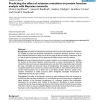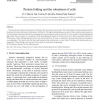420 search results - page 19 / 84 » A graphical model for predicting protein molecular function |
BMCBI
2006
13 years 7 months ago
2006
Background: A number of methods that use both protein structural and evolutionary information are available to predict the functional consequences of missense mutations. However, ...
BIOINFORMATICS
2007
13 years 8 months ago
2007
Motivation: Protein–protein complexes are known to play key roles in many cellular processes. However, they are often not accessible to experimental study because of their low s...
BMCBI
2007
13 years 8 months ago
2007
Background: Most methods for predicting functional sites in protein 3D structures, rely on information on related proteins and cannot be applied to proteins with no known relative...
BIOSYSTEMS
2007
13 years 8 months ago
2007
The intricate intracellular infrastructure of all known life forms is based on proteins. The folded shape of a protein determines both the protein’s function and the set of mole...
AI
2005
Springer
13 years 7 months ago
2005
Springer
Abstract. The protein family classification problem, which consists of determining the family memberships of given unknown protein sequences, is very important for a biologist for ...


